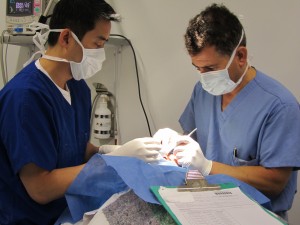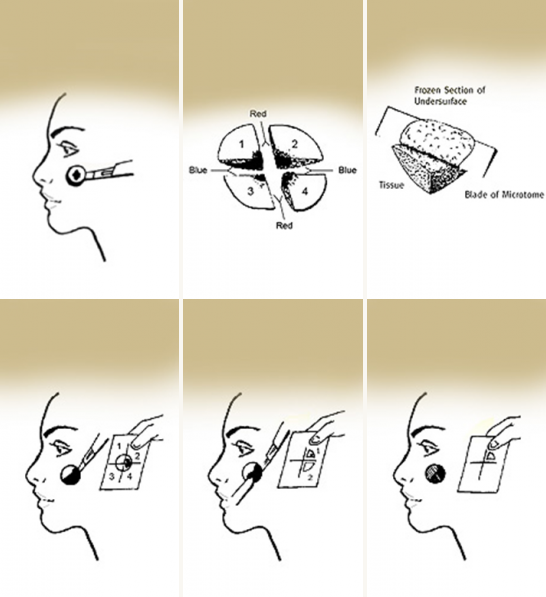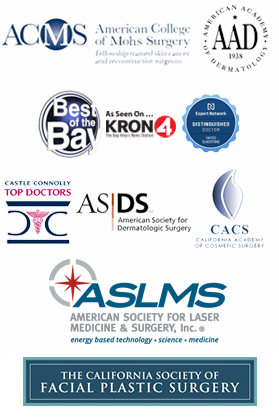Mohs Surgery
Upon learning they have skin cancer, patients ask Dr. Hayes Gladstone how to treat it. The answer very often is Mohs surgery, which is expertly performed here at Gladstone Clinic for those in San Ramon, Danville, Pleasanton, San Francisco, and the surrounding communities in California.
The Gladstone Clinic offers Mohs Micrographic Surgery. Mohs skin cancer surgery is used to treat the most common forms of skin cancer: basal cell carcinoma and squamous cell carcinoma. It currently offers the highest cure rate for primary and recurrent nonmelanoma skin cancer. It is considered the gold standard. This technique is also used for less common skin cancers.
What Is Mohs Surgery?

Why Is Mohs Surgery Different?
Mohs surgery permits the immediate and complete microscopic examination of all the margins of the treated cancerous tissue. The Mohs surgeon is specifically trained to interpret the tissue under a microscope. The definition of a Mohs surgery is that the skin is biopsied and examined under a microscope by the same specialist. Careful examination ensures that all of the cancerous tissue is treated. Mohs surgery treats only the cancerous tissue and spares the normal tissue.
How is the Mohs Surgery Performed?
Watch Dr. Gladstone Discuss Mohs surgery
The procedure is performed in the comfortable setting of the Gladstone Clinic. Your biopsy site is identified, then marked and numbed up similar to your skin biopsy. After a few minutes, Dr. Gladstone biopsies a small piece of skin—a minimum of normal skin is treated. This is particularly important in cosmetic-sensitive areas such as the face. A bandage is placed on your wound. Dr. Gladstone takes your skin to his lab in the office where it is cut and stained. He methodically and precisely maps the location of the tumor. This process takes about 30 minutes, and patients can either stay in the exam room or go to the waiting room and read or eat. Dr. Gladstone strives to perform Mohs as accurately and expeditiously as possible, but the Mohs surgery and the reconstruction performed by Dr. Gladstone may take 4-5 hours depending on the size of the tumor and complexity of the defect.
If there is still skin cancer, then Dr. Gladstone will numb the area, and again take a small piece of skin based on his precise microscopic mapping. This continues until all skin cancer has been treated.

Figure 1– The area to be treated is cleansed, marked, and injected with a local anesthetic. The Mohs surgeon removes the visible cancer, along with a thin layer of additional tissue. This procedure takes only a few minutes, and the patient waits while the tissue is processed and examined.
Figure 2 – Tissue cut in a saucer shape. The removed tissue specimen is cut into sections, stained, and marked on a detailed diagram called a Mohs map.
Figure 3 – The tissue is frozen on a cryostat, and a technician removes very thin slices from the entire edge and undersurface. These slices are then placed on slides and stained for examination under a microscope. This is the most time-consuming portion of the procedure, often requiring an hour or more to complete.
Figure 4 – The Mohs surgeon carefully examines the entire undersurface and compete edge of the specimen, and all microscopic “roots” of the cancer are precisely identified and pinpointed on the Mohs map. Upon microscopic examination, if residual cancer is found, the Mohs surgeon utilizes the Mohs map to direct the removal of additional tissue (Figure 2). Note that additional tissue is removed only where cancer is present.
Figure 5 – This process is repeated as many times as necessary to locate any remaining cancerous areas within the tissue specimen (Figure 3, Figure 4, etc.)
Figure 6 – When microscopic examination reveals that there is no remaining tumor, the surgical defect is ready for repair.
Why Have Your Mohs Surgery Done At The Gladstone Clinic?
Dr. Gladstone completed a yearlong surgery fellowship accredited by the American College of Mohs Surgery. It was a highly selective fellowship in Mohs surgery and reconstruction. Previous to that training he completed a residency in Dermatology and trained in Otolaryngology-Head and Neck Surgery. Prior to medical school, he was a professional photographer. From 2000-2011, Dr. Gladstone was the Director of the Division of Dermatologic Surgery and Chief of Mohs surgery at Stanford University. He has lectured nationally and internationally on Mohs surgery and published many articles. This background provides Dr. Gladstone with the skills and vision to perform Mohs surgery at the highest level.
The Gladstone Clinic is passionately committed to curing your skin cancer and minimizing your scar. Using the latest and most advanced procedures for skin cancer & reconstructive surgery, our team offers services emphasizing overall health and wellness to the residents of San Ramon, Danville, Pleasanton, Manteca San Francisco, and the surrounding communities in California. Please contact us today to schedule a Mohs micrographic surgery consultation.
*Individual results may vary.



